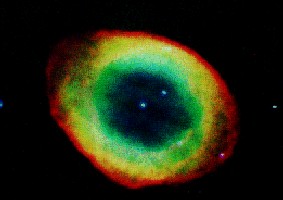Lyra
The “Summer Triangle”, consists of the stars Vega, Deneb and Altair. The brightest of these stars, blue-white Vega is also the brightest star in the small constellation of Lyra. Vega is the fifth brightest star in the sky but its brightness owes more to its proximity than its intrinsic luminosity. Vega is an ordinary main sequence star and at a distance of 26 light years, one of the closest of the first magnitude stars to us. In 1850 Vega became the first star ever to be photographed and in 1963 one of the first to have its diameter (three times that of the Sun) measured by interferometry. In 1983 it was discovered that Vega is surrounded by a disk of cold dark dust that may be in the process of coalescing into a planetary system much like our own Solar System.Lyra has much more to offer than just Vega. Close to Vega for instance is the celebrated “double double”, Epsilon Lyrae. Binoculars and even keen naked eyesight will split Epsilon into two stars, but a telescope under high power will show that each component is itself a close double. It is thought that the four stars form a true physical system, gigantic in size compared with the Solar System with the two doubles taking about a million years to orbit each other.

M57 (Ring Nebula)
Lyra possesses one globular cluster from the Messier catalogue (M56), but the showpiece deep-sky object is undoubtedly the planetary nebula M57, also known as the “Ring Nebula”. This is probably the best known example of this type of object although others (such as M27 in nearby Vulpecula) are brighter and larger.
POWERPOINT SLIDE SHOW (243KB)